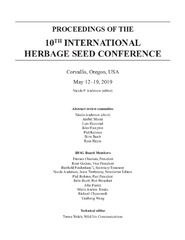Приказ основних података о документу
Genetic Variation of Alfalfa Seed Yield in the Establishment Year
| dc.creator | Karagić, Đura | |
| dc.creator | Milić, Dragan | |
| dc.creator | Katanski, Snežana | |
| dc.creator | Milošević, Branko | |
| dc.creator | Zorić, Miroslav | |
| dc.creator | Julier, Bernadette | |
| dc.date.accessioned | 2023-12-19T09:00:45Z | |
| dc.date.available | 2023-12-19T09:00:45Z | |
| dc.date.issued | 2019 | |
| dc.identifier.uri | http://fiver.ifvcns.rs/handle/123456789/4161 | |
| dc.description.abstract | In Serbia, alfalfa (Medicago sativa L.) is grown on about 140,000 ha, out of which 3–7% are intended for seed production. Climatic factors (amount and distribution of precipitation) are the main determinants of alfalfa seed yield. Average alfalfa seed yield in Serbia is about 250 kg ha-1, and seed production is characterized by huge variation (15–800 kg ha-1). The most challenging year for seed production is the establishment year, i.e., the first year of plant life. To be successful on the market, new alfalfa varieties are selected for high forage production, quality of forage, and persistence. However, outstanding seed-yield potential is also needed. Even if breeding for seed yield is not prioritized, genetic variation among cultivars is known. In order to explore genetic variation for alfalfa seed yield and its components in the establishment year, a trial with 400 accessions was established at the experimental field of the Institute of Field and Vegetable Crops, Novi Sad, Serbia, on May 21, 2018. The genotypes were tested in a partially replicated design. For the purpose of this study, we extracted model best linear unbiased predictions (BLUPs) for 20 populations, which represent a part of the European alfalfa core collection. The plot size was 6 m2 . Seed yield and its components were recorded for each plot. The 2018 field season was not favorable for alfalfa seed production in Serbia, but the results clearly demonstrate differences among varieties for total seed yield and its components in the establishment year. Seed yields varied from 31.8 kg ha-1 for the variety ‘Tereza’ to 96.7 kg ha-1 for the variety ‘Etincelle’. Higher seed yields were obtained with less dormant varieties (dormancy ratings 5–6), while lower yields were recorded with more dormant varieties (dormancy ratings 3–4). Analyses showed that, even under unfavorable conditions, genetic variation could be important for alfalfa seed production in the year of establishment. | sr |
| dc.language.iso | en | sr |
| dc.publisher | International Herbage Seed Group (IHSG) | sr |
| dc.relation | info:eu-repo/grantAgreement/EC/H2020/727312/EU// | sr |
| dc.rights | openAccess | sr |
| dc.source | Proceedings, 10th International Herbage Seed Conference, Corvallis, Oregon USA, 12-19 May 2019 | sr |
| dc.subject | alfalfa | sr |
| dc.subject | seed yield | sr |
| dc.subject | variety | sr |
| dc.subject | genetic variation | sr |
| dc.title | Genetic Variation of Alfalfa Seed Yield in the Establishment Year | sr |
| dc.type | conferenceObject | sr |
| dc.rights.license | ARR | sr |
| dc.citation.epage | 94 | |
| dc.citation.spage | 91 | |
| dc.identifier.fulltext | http://fiver.ifvcns.rs/bitstream/id/9959/bitstream_9959.pdf | |
| dc.identifier.rcub | https://hdl.handle.net/21.15107/rcub_fiver_4161 | |
| dc.type.version | publishedVersion | sr |


